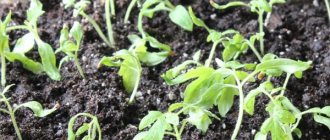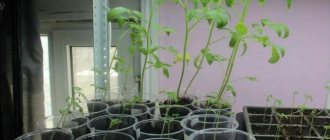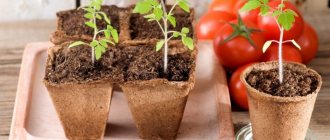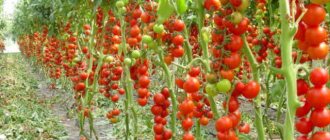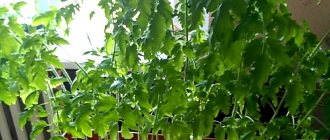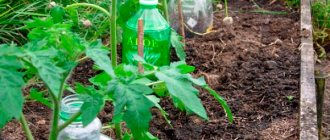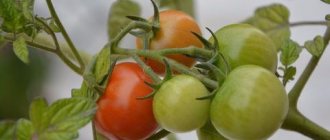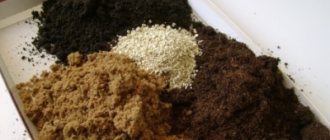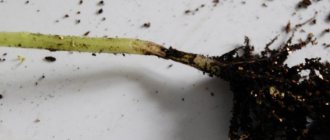How to properly care for tomatoes
An unusual way to water tomatoes.
After planting tomatoes, it is not recommended to water them for 2-3 weeks. For rooting and growth, the water that you poured into the holes before planting is quite enough. Water the plants later, but don't overdo it. It is recommended to water the tomatoes at the root using settled water at room temperature. When watering from a watering can (sprinkling), the plants suffer because the temperature of both the soil and the air drops sharply. This has a bad effect on flowering, the ovary occurs much later, most of the flowers fall off, and the fruits ripen late.
High air humidity causes the growth of green tomatoes to stop, the already red fruits to crack, and blossom end rot to spread.
After each watering, be sure to loosen the soil and destroy weeds. The first loosening is 8-13 cm, the next ones are 5-6 cm. The first loosening helps to warm up the top layer of soil in order to normalize the temperature regime for tomatoes. Subsequent loosening is necessary to ventilate the root system. Lower leaves that age and darken should be removed in a timely manner (once a week is enough).
How to properly feed with fertilizers
Tomatoes love fertilizers.
Most of all, the plant needs potassium, especially during the fruiting period. Potassium has a positive effect on growth at the first stage of development, on the formation of stems, ovaries, fruits, and helps the plant survive a lack of light.
It is necessary to remove the lowest leaves that touch the ground and all unnecessary stepsons as they appear.
Nitrogen is used by the plant for the formation of vegetative organs from the moment of germination to the beginning of flowering. You should not “feed” the plant with nitrogen, because such generosity will lead to the formation of very lush greenery, and the flowers from the lower inflorescences may even fall off. If you still decide to increase nitrogen fertilizing, then do it after setting fruit on the first inflorescences.
In addition, tomatoes require fertilizing in the form of fertilizers containing calcium, magnesium and iron.
Mineral fertilizers are often given in liquid form, immediately after watering. The first feeding is carried out 2 weeks after planting tomatoes in the soil, this is the approximate time when ovaries begin to form on the plant (on the first inflorescence). At this time, phosphorus-potassium fertilizers are recommended (15-20 g of potassium sulfate and 20-25 g of superphosphate per 1 m2). Nitrogen fertilizers should be added when the soil is poor and this significantly affects plant growth (we add up to 10 g per 1 m2 of ammonium nitrate).
We carry out other feedings during fruit growth and ripening.
Air temperature requirements
In order for seedlings to grow viable, certain temperature conditions are created for them corresponding to the stage of development.
When planting seeds
The seeds are germinated before sowing. This procedure increases their germination rate. Planting material is germinated at temperatures from +25 to +30 °C. At lower values, seeds will germinate much more slowly.
To ensure optimal temperature conditions, germinated seeds are placed on a radiator. It is important to promptly moisten the fabric in which the planting material is wrapped.
When the seeds are sown in the ground, the temperature in the room is maintained from +24 to +26 °C.
How to ensure the required conditions:
- Cover the box with the seeds with film.
- Place foam under the bottom of the box.
- Windows should provide maximum light, so boxes with crops should be placed on the south side.
After germination
When seedlings appear in the seedling boxes, the temperature is adjusted in such a way as to grow the strongest seedlings.
Temperature conditions after germination:
- First week. Maintaining low temperatures during the first week after germination helps prevent sprouts from stretching. Recommended temperatures:
- daytime – from +13 to +18 °C;
- night – from +11 to +14 °C.
- Second week. The temperature is gradually increased. Recommended values:
- on clear days – from +20 to +23 °C;
- in cloudy weather – from +18 to +20 °C;
- night – from +17 to +19 °C.
Many experienced gardeners adhere to other rules; they believe that temperatures should be lower:
- in cloudy weather – from +16 to +19 °C;
- at night – from +10 to +13°C.
Extreme caution must be taken as the temperature drops. Even a loss of 2-3 degrees Celsius can negatively affect seedlings.
A slight drop in temperature can provoke:
- weakening of the root system;
- developmental delay, which will negatively affect productivity.
Overheating has an equally detrimental effect on the development of seedlings. The sprouts stretch out, their stems become thin and weak.
At this stage, daylight hours should be at least 10 hours. If there is not enough light, turn on the lamps. The soil is moistened with a spray bottle, avoiding stagnation of water.
After the pick
If the seeds were sown in a common container, the seedlings have to be picked - planted in separate 0.5 liter glasses.
Recommended temperatures after picking:
- on clear days – from +20 to +23 °C;
- in cloudy weather – from +16 to +18 °C;
- night – from +12 to +15 °C.
Proper watering and lighting
Most varieties of cultivated tomato bear fruit both in long and short daylight conditions. To get a good harvest, it is worth increasing the light intensity for plants.
When growing with buried stepsons, the first side shoots - the stepsons - are not removed, but are allowed to grow longer. Next, I tear off the leaves from them, bend them to the ground and cover them with a 10-12 cm layer of soil.
Light intensity directly affects the yield and fruiting of tomatoes. With a lack of light, plant growth is very quickly disrupted. Thus, cloudy weather can increase the period from the beginning of flowering to the ripening of tomatoes by as much as 10-17 days. The taste and quality of fruits noticeably deteriorate in bad weather.
Tomatoes are relatively moisture-resistant, but they still need quite a lot of water. The frequency of watering and the volume of water depend on the specific characteristics of the soil, the level of solar radiation and the condition of the plant as a whole. It is recommended to water tomatoes indoors in the morning, once or twice a week, mainly in warm weather. In open ground, plants can be watered in the evening until 19-20 hours. The water temperature should reach +20°C. Watering too frequently can lead to a deterioration in the air condition of the soil and negatively affect the overall activity of the root system.
Air humidity, like temperature, has a direct effect on the fertilization of tomato flowers.
The optimal humidity for growing this crop is 60-70%. At higher humidity levels (80-90%), the pollen on the flowers sticks together and stops falling out. Also, with high air humidity, there is a high probability of fungal and bacterial diseases. Low humidity leads to the fact that the pollen that falls on the pistil does not germinate at all, and therefore the fruits are not set.
Protecting seedlings from heat
If the weather forecast predicts hot weather, this factor should also be taken into account in your plans and work in the garden. The fact is that high temperatures when growing tomato seedlings negatively affect the plant’s vitality, and in some cases kill the plant altogether. In order to save the bush, you need to take several measures:
- It is important to create shelter from the sun's rays; for this you can use a spandex. This material is capable of allowing moisture and air to pass through, but at the same time it perfectly retains the sun’s rays, which are often detrimental to the vegetable;
- Take care that the soil does not dry out. To do this, experienced gardeners use a technique called mulching. You need to lay mowed grass and sawdust on the ground (a layer of at least 4 cm), and the material should be placed near the trunk of the plant. In addition to the fact that after this the soil will remain moistened longer, you will be able to protect the soil from overheating and allow morning dew to penetrate into the ground;
- YOU can also create a screen using tall plants such as grapes and corn. This is necessary so that the crop is not exposed to drafts and is also reliably protected from the sun.
In conclusion, let’s say that in Russia, when planting seedlings, it is important to carefully monitor the weather forecast, because the weather can be quite unpredictable, although, of course, the likelihood of a sharp drop in temperature and night frosts on the soil in June is small.
What temperature can tomato seedlings withstand?
Without exception, all modern tomato varieties are heat-loving plants. And although the manufacturer may indicate on the seed packages that a given variety or hybrid is cold-resistant, this will only tell the buyer that the seedlings will survive when the air temperature drops to +5-8°C for a short period. On sale you can find varieties “Far North”, “Sanka” and “Yamal 200”, which for a short period of time (up to 12 hours) can survive cold temperatures down to +10°C, but not negative degrees.
What does it mean to survive? The plant will continue to grow after such an extreme cold snap, but even in this case it will need at least a week to recover, which means the harvest will be delayed by this period.
Temperature is important for seedlings
When the temperature drops to +5°C, ordinary tomatoes can freeze, just like bell peppers. They wither and die, as sap flow inside the plant completely stops. Moreover, if at night the temperature drops to +8°C, even with very strong seedlings, all the buds will most likely wither and fall off in the morning; it is extremely undesirable for seedlings to freeze. After such severe stress, it will be difficult for tomatoes to recover. If we are talking about common mid-season varieties, then they stop flowering and growing already at +15°C. When a cold snap occurs in the middle of summer to +10°C, the already formed green fruits will stop ripening.
A simple procedure for hardening off seedlings helps solve the problem of unexpected cold snaps. To do this, young asthenia with 3-4 leaves in boxes are taken out into the fresh air in the spring, or left on balconies with the windows open in the warmest afternoon (from 2 to 4 o’clock). The optimal air temperature for this is +15°C. This measure helps achieve several very important goals at once:
- Establishment in a cold garden bed in open ground will be less painful, since during a week of hardening the root system of the seedlings will have time to get stronger.
- The leaves of young tomatoes will become accustomed to sunlight. In the garden bed, the sun will no longer burn the leaves.
- The plants will feel the real wind, so they will gain elasticity and will not break at the first gust after transplanting.
- If a sudden frost occurs, hardened plants will have a much better chance of surviving.
Important! To obtain a bountiful harvest, hardening is a prerequisite. It will not be able to harm the seedlings, but will only bring benefits
“Walks” start at 1 o’clock. Then add 0.5 hours - 1 hour per day. Finally, you can even leave the boxes in the open air overnight if the nighttime air temperature does not drop below +10°C.
Features of hardening
Speaking about tomato sprouts, we cannot fail to mention the need to harden off the seedlings. The fact is that before encountering temperature changes, it is worth preparing the plant, that is, hardening it so that it can withstand low temperatures and get used to the new regime.
The first hardening is optimally carried out 2-3 weeks before the seeds arrive at the permanent growing site. Usually a balcony is chosen for this procedure; this place allows the plant to most gently adapt to exposure to sunlight, as well as accustom it to cold air.
Duration of hardening
If it is warm outside, that is, the thermometer shows more than 12°, then at first the seedlings are taken outside for a period of about 2-3 hours, repeating the procedure for several days. After 3-4 days, you can move on to round-the-clock hardening, that is, leaving the seedlings for the whole day.
However, if you leave the plant outdoors overnight, it is still recommended to cover the containers, especially if it is not too warm at night. At the same time, it is strictly forbidden to take the seeds outside if the temperature outside the window is below 10°, they will not tolerate this.
How to understand that hardening was successful? If you notice a purple tint on the leaves of a tomato bush, you can say that the bush is ready to be transplanted to a permanent place of germination and cultivation, that is, in a greenhouse or open ground.
Under no circumstances should the tomato bush be exposed to direct sunlight, otherwise it may cause burns on the foliage. It is better to place containers with sprouts on the shady side; this is the only way to grow a strong plant.
How to influence tomatoes with temperature changes?
Of course, it is possible to create optimal temperature conditions for tomatoes only in heated greenhouses. However, based on these indicators, it is easy to understand that some secrets can be applied to open ground, balcony cultivation, and cultivation in unheated greenhouses.
If you want to reduce the waiting time for tomato seedlings, you need to raise the temperature to +20...+25°C.
It is possible to prevent tomato seedlings from stretching out immediately after germination by lowering the temperature for 2-3 days to +10...+15°C.
When hardening off tomato seedlings before planting in the ground, sharp temperature fluctuations should not be allowed, as this causes stress in the plants and provokes inhibition of their development.
Proper hardening of tomatoes ensures their resistance to short-term temperature drops to 0°C.
By planting seedlings in an unheated greenhouse or under film, you can speed up production. However, it must be remembered that when the temperature in a film greenhouse rises above +30°C in combination with high humidity, fertilization of tomatoes does not occur, the color falls off, and if fruits are formed, there are few of them, they are small and hollow. After such stress, normal (productive) pollen is formed only after 10-14 days.
When planting tomatoes in open ground, it is necessary to take into account the optimal timing for the given area. A delay in planting, even by 10 days, already significantly reduces the yield.
In the summer in the southern regions, in order to somewhat reduce the temperature and maintain humidity in the area of tomato bushes, shading can be installed on tomato plantings - a camouflage net, or resort to a two-line placement of the crop, which ensures mutual lateral shading of the rows, which is also the prevention of fruit burns that occur at temperatures above +34°C.
Mulching tomatoes not only retains moisture in the root zone of the soil, but also somewhat reduces its temperature, which has a good effect on the metabolic processes of plants.
For tomatoes, not just high or low temperatures are important, but also the nature of their fluctuations. If plants are constantly kept at high temperatures, then the substances they form during the day necessary for growth and development are spent on respiration at night. This slows down their development and ultimately affects productivity. When temperatures fluctuate and decrease in the evening, the process of flowering, setting, and then ripening of tomatoes accelerates.
What happens to seedlings when the temperature regime is violated
Unsuitable conditions for seedlings entail many problems with the plant: from instability to diseases and pests to a meager harvest.
Low temperatures cause the stem to thicken and reduce its growth, which is not good. With a significant increase in temperature, the sprouts exhibit an elongated stem and small, pale leaves.
How does low soil temperature affect seedlings?
A slight reduction is sometimes beneficial for the tomato. In this way, you can get the correct development of the root system, which will affect the harvest in the future. The maximum period allowed for reducing the temperature is from one to two weeks.
Planting seedlings at low temperatures risks stopping the supply of nutrients to the root system. In case of severe frosts, the plant may die. If the cold weather cannot be avoided, then you can create a special shelter on the arcs. Sometimes summer residents use ordinary plastic bottles, but this method is only suitable if the cold snap is temporary. With a regular drop in temperature, unfortunately, the death of the plant cannot be avoided.
Effect of high temperature
Prolonged heat deprives the tomato of vitality, dries out the soil and slows down the growth of the bush. Often the plant begins to hurt, for example, with blackleg.
Maximum temperature for tomatoes
Excess heat is just as harmful to plants as too little heat. For heat-loving tomatoes, the maximum estimated temperature is determined at 40-50 degrees, for cold-resistant tomatoes at 30-40 degrees. Its increase leads to disruption of vital functions and death of plants. Therefore, the issue of correct temperature regulation for tomatoes day and night is very important. The practice of growing vegetables in greenhouses proves that a decrease in temperature at night against the optimum promotes enhanced plant development and increased yield. This is explained by the fact that at night, due to the lack of light, the assimilative activity of plants stops, and the respiration process associated with the consumption of accumulated nutrients continues uninterrupted. On cloudy, cloudy days, the assimilation process in plants is also weakened, that is, when the temperature drops at night and on cloudy days, respiration energy decreases, and therefore the consumption of plastic substances decreases.
Features of planting tomatoes
When planting tomato seedlings and seeds in soil, both the ambient air temperature and the heat indicators in the soil itself at the planting depth are important.
Planting tomato seedlings in insufficiently warmed soil means dooming the plants to disease.
The optimal temperature for tomatoes is 15ºС. When the thermometer readings are below 10ºC, the root system of tomatoes does not grow and rots, respectively, 10°C is the minimum permissible temperature.
Recommendations
Film shelters for tomato plantings allow you to warm the soil to the maximum possible level to the required thermal regime if you close them immediately after planting, especially at night. In emergency cases, when seedlings need to be replanted, but there is no time to warm up the soil, the planting time is not postponed, and when planting tomato bushes, a small amount of hot water is poured into each hole. Such watering at the initial stage provides the seedlings with the required day and night temperatures, which can be easily maintained by covering the plantings or using artificial heat.
The established temperature regime for tomatoes affects whether the plants will take root, whether they will actively grow, develop and bear fruit in the future.
Before planting tomatoes, you should check the weather forecast. The absence of frost will allow the plant to gain a foothold in the soil and withstand even unexpected cold.
To avoid the death of tomato bushes at less than optimal temperatures during planting, rooting them to a shallow depth allows them to be rooted.
How temperature is needed for seedlings to germinate and grow.
Temperature is one of the most important indicators of the quality of tomato seedlings. The fact is that the seeds of most vegetable crops are very small and have an insignificant supply of nutrients. Therefore, during the period of emergence of seedlings, it is necessary to stimulate the development of the root system of tomatoes, supplying it with water and nutrients dissolved in it, and stop the growth of the above-ground mass. The latter is achieved by reducing the temperature to 13 degrees within 5-7 days; unfortunately, in apartment conditions it is difficult to find a place with such a temperature. (start it after 75% of shoots appear)
Vegetable crops have different requirements for thermal conditions at different stages of their development. In most of them, the seeds germinate strongly at temperatures below the optimum established for these plants during the growing season. Tomatoes germinate from +10 to +15 degrees.
Tomato seedlings are frozen
Based on the experiments conducted, it can be argued that when the temperature drops during the emergence of seedlings, all plants intensively develop the root system, and the growth of above-ground vegetative mass slows down. For example, seedlings of cabbage and lettuce turn out lower, stockier and have a more developed root system. When the soil was heated to +17°, tomatoes reacted positively, cabbage - negatively, radishes and lettuce gave a neutral reaction.
In the future, the daytime temperature is maintained depending on the need for it by a given variety of tomatoes, and special attention must be paid to maintaining the night temperature. Excess heat at night leads to an increased consumption of nutrients, the formation of which in the early period is difficult (low illumination, lack of the required spectral composition, low temperatures, etc.), to stretching, overgrowth, and weakens the plants, which, in turn, is the cause reducing cold resistance and survival rate of seedlings planted in open ground
Frosts and minimum temperatures for tomato seedlings
The minimum temperature for each tomato variety will be different. For the culture as a whole, the temperature range is quite wide: from 0°C to +43°C. There are frost-resistant varieties, which, according to gardeners, do not die even in frosts down to -40°C, but only in calm weather and subject to exposure to negative temperatures for tomatoes at night for an extremely short period of time. If the nights are still frosty, then you shouldn’t hope for the “heroism” of your seedlings - they will simply die. Knowing what frosts tomatoes can withstand, you can plan the date of planting in the beds.
Among the factors that significantly increase the resistance of tomatoes to low temperatures are the following:
- Zoning. You should buy seeds that are zoned for the buyer’s specific area of residence.
- Low bush size with a powerful thick stem.
- Large and strong root system.
- Excellent nutrition and regular watering.
- Protection from pests and common diseases.
- Hardening.
If frosts are coming and sub-zero temperatures are inevitable, don’t despair. Plants can be saved even in such a hopeless situation. In the greenhouse they place one or several dark-colored barrels (as many as there are) filled with water. Even in May, it is already warm enough during the day for the water in the barrels to warm up well, and at night it gradually releases heat, heating the air in the greenhouse.
Planting in open ground will help save the covering material. For this purpose, you can use film or agrofibre. If the day promises to be cold, then the shelter is left during the day and the next night too. When the sun appears, the film is removed, but continue to closely monitor the thermometer and the weather forecast.
What determines the quality of the crop?
Watering. Until the seedlings have taken root, you should refrain from watering. The first watering should be done approximately 10 days after planting. The water should have an average temperature of +20-23 degrees. After flowering begins, watering should be increased from 5 liters per 1 sq. meter to 10 liters.
Ventilation. Two hours after watering and at other times, the greenhouse should be ventilated by opening the windows or door and lifting the film. This should not be neglected, because temperature conditions are very important, especially during flowering.
Garter. Already on the third day after planting, you need to start tying. The procedure is carried out so that the stem of the plant does not break under its own weight, and the fruits do not rot.
Stepsonning. Stepchildren are the side shoots of a plant that grow not on the stem, but from the axils of the leaves. In this way, they branch the bush, which leads to shading, the spread of diseases and a reduction in the ripening period of the fruit.
Important! The pinching procedure is usually carried out in the morning to dry the wound. Top dressing
Without fertilizing, it is unlikely that you will be able to get a really large and juicy harvest. The first feeding is applied 10-15 days after planting, the second - after another 10 days. Ultimately, the procedure needs to be done four times during the season.
Feeding. Without fertilizing, it is unlikely that you will be able to get a really large and juicy harvest. The first feeding is applied 10-15 days after planting, the second - after another 10 days. Ultimately, the procedure must be done four times during the season.
Tell me, what kind of frost can plants in a polycarbonate greenhouse withstand without additional shelter?
Lesnaya
Don't take risks. You won't be able to control your temperature at night. With good night frost, even zero temperature in the greenhouse can destroy the seedlings of some plants. Of course, the greenhouse is several degrees warmer at night. It also depends on the design of the polycarbonate greenhouse, how airtight it is. Therefore, during spring frosts it is better to keep covering material ready. In the evening it began to get colder sharply... run and throw it over the plantings in the greenhouse.
Serafima Arkadyevna
I think they will last up to -5. A difference of 10-12 degrees at night gives us +5+7 in the greenhouse
Brunette
Last year, around this time (end of April), I specifically noticed several times at night the temperature difference in the greenhouse and outside - only 2-3 degrees. To prevent my tomatoes, peppers, eggplants and other seedlings from disappearing, I installed an oil heater (set to two) in the greenhouse for several nights, when it was only +7-8 outside. Then at night the temperature in the greenhouse was +14.
Unfortunately, polycarbonate greenhouses cool down very quickly.
Olga
If you close the doors tightly, then inside + If it’s cold, I cover the tomatoes in wire arcs with lutrasil
droplet
if you put arcs inside and cover them with spandbond and film, then at -10 nothing froze, but I also light two thick candles and put buckets of water
General optimal temperatures for tomato development
The optimal regime for the growth, development and fruiting of a tomato is considered to be a temperature within the range of +20...+25°C in combination with high illumination. In low light, in cloudy weather, these are already indicators of +15...+18°C in the daytime and +10...+12°C at night.
An increase in temperature to +30...+31°C, combined with low air humidity, which is observed annually in the southern regions, inhibits the process of photosynthesis of the crop, and therefore the processes of plant development. Temperatures above +35°C lead to their starvation and death.
The lower temperature threshold for southern tomato varieties is -1°C, for northern ones - -3...-4 °C in the absence of wind. It is worth mentioning that northern varieties grow and develop in a slightly wider temperature range of +8...+30°C, southern varieties +10...+25°C.
The lower threshold of soil temperature, which promotes the full functioning of the root system of tomatoes, is equal to +14°C. The optimal soil temperature for the full growing season of seedlings is +23...+25°C, for adult plants - +18...+22°C.
Flowering tomatoes. Harvest to Table
Planting in open ground
It is better to plant seedlings in open ground on a cloudy day.
After the first tomato shoots have appeared, they can be sent to a permanent place of growth. If you plan to plant a bush in open ground, you should definitely wait for a cloudy day, this is extremely important. At the same time, it’s not bad if the nighttime soil temperature is about 12°, maybe a little higher.
Conditions for planting and growing seedlings in a greenhouse
Growing tomatoes does not require much effort from gardeners, which is why they are so widespread. Even in deserts, where the soil is very poor, local residents do everything possible to get the coveted harvest.
Still, it takes a little effort to create favorable conditions for a good harvest. What should you do before boarding?
Tomatoes in a greenhouse
Prepare the greenhouse
As you know, it is in the greenhouse that the harvest is several times larger. But it is possible to achieve a harvest and prevent diseases only if the greenhouse is properly prepared.
Since tomatoes are planted in early May, the seedlings should easily tolerate fairly cold nights. Therefore, it is necessary to cover the greenhouse with a double layer of film, if it is not made of glass or polycarbonate.
It is necessary to leave a so-called air cushion between the layers of polyethylene, which increases the temperature inside the greenhouse and increases the service life of the inner layer. Be sure to make vents for ventilation.
Important! It is impossible to plant tomatoes in the same greenhouse for two years or more; infections, bacteria and pests remain in the soil, which can destroy new seedlings
Prepare the ground
Before planting a new crop, you need to start preparing the soil 10-14 days in advance. You should get rid of last year's soil by 10-15 centimeters, and treat the rest with the well-known copper sulfate in the proportion of 1 tbsp. l per 10 liters of water. Loosen the finished beds, get rid of numerous weeds and fertilize with humus.
The more fertile the soil, the less humus will be needed. And, accordingly, vice versa.
Prepare the seedlings
Properly prepared seedlings play a very important role in the quality of the harvest. You will need boxes or boxes about 10 centimeters high. Inside is placed either a purchased soil mixture or one prepared from peat, humus and turf soil in equal quantities. The soil must be moistened.
After the soil has been compacted, they begin to form furrows (they are usually made 1-2 centimeters deep). Having placed the seeds and covered them with the prepared mixture, the container should be placed in a bright place.
Important! After 5 days it should be covered with a film cap. This way the seedlings should sprout faster
About a week or a little later after germination, two true leaves should appear. When this happened, it was time to dive. This is the transplantation of plants from one container to another, more spacious one. This is a mandatory stage: the root system has already become stronger and requires more space.
Each plant is removed along with the soil (usually using a toothpick) and moved into a spacious pot.
To prevent the seedlings from stretching out, the gardener must observe the temperature regime and monitor the lighting, changing the side facing the light every day.
Typically, seedlings are kept in pots for no more than 50 days, during which time their height reaches about 30 centimeters. When there are 10 days left before planting tomatoes directly in the greenhouse, they should be regularly hardened off on the balcony or with the window open all night.
When planting seedlings is prohibited
It is worth talking about the conditions when it is strictly forbidden to replant seedlings. This is especially true in cases where the seedlings were purchased on the market, that is, you do not know under what conditions they were grown.
If according to the weather forecast you see that frosts are expected at night in the near future, it is better not to plant tomato sprouts. The fact is that you cannot be 100% sure that the sprouts were hardened off properly. Such a plant will not survive even one such sharp drop, which will lead to the inevitable death of the bush. To increase the chances of survival, it is recommended to treat the root system of the bush with a solution of potassium permanganate immediately before planting.
Sources:
https://7ogorod.ru/pomidory/temperatura-rassada-tomatov.html https://rufazenda.ru/temperaturnyiy-rezhim-pri-vyirashhivanii-rassadyi-tomatov.html https://fermoved.ru/pomidoryi/temperatura- dlya-rassady.html
How to collect and preserve the harvest
The maturity of tomato fruits is usually divided into 2 categories: biological and technological. Biological maturity is the process of seed formation and their covering with a hard shell. At this stage, fetal growth stops and the green color becomes lighter. The harvested fruits at this time will be able to easily endure long-term transportation. In 5-6 days, the fruits acquire their characteristic color and accumulate vitamins, sugars, and acids.
If at this stage you have not yet reaped the fruits, then now is the time to do so, because technological maturity has arrived. The fruit, although not yet red, is completely suitable for consumption.
Overripe fruits lose most of their vitamins and nutrients, the taste of such tomatoes deteriorates sharply, and the fruit tissues completely soften. As a result, you will be disappointed in the long-awaited harvest.
So, the rules for caring for tomatoes that you should remember
- Maintain the recommended air and soil temperatures for tomatoes.
- Provide good lighting.
- Monitor the humidity and avoid sudden changes.
- Fertilize the soil.
- Remove spoiled leaves and fruits in a timely manner.
Temperature at which tomatoes in a greenhouse will freeze
Some vegetable crops freeze or stop growing when exposed to sudden cold weather. This significantly affects plant productivity. The first to feel the cold are heat-loving crops growing close to the soil, including tomatoes.
The correct temperature regime in a greenhouse is the key to a stable and high-quality harvest. Therefore, if the climate of your region is not suitable for growing tomatoes, the air temperature of the greenhouse must be adjusted. If automated heating of a greenhouse is too expensive, you can use simpler heating options, such as mulching the soil, additional covering with film, and the like. Having stabilized the temperature to normal, you need to maintain the set mode, either turning on the heating or ventilating the greenhouse space.
The importance of temperature conditions when growing tomato seedlings
Inexperienced gardeners who want to get an early harvest sow tomato seeds as early as possible. They believe that the sooner you plant, the sooner you can enjoy the delicious fruits. But as a result, they acquire weak shoots and a lot of hassle in caring for them.
These situations arise if tomato seeds are planted very early, for example, in February. At this time, the day is short, and the air temperature is far from what the vegetable needs. For a heat-loving plant, frosts and sudden temperature changes are very dangerous.
At what temperature do seedlings die?
If the temperature in the greenhouse is less than +15 degrees, the seedlings take root very poorly, because the absorption of minerals is less effective, the roots slow down their development, and access to water is much more difficult.
If the temperature is +10 degrees, the roots of future fruits stop growing because they are not able to absorb nutrients.
If the temperature drops to +5 degrees and below, the seedlings not only freeze, but also die due to damage. And at +0.5 degrees and even minus values, the plant dies instantly.
Tips and recommendations from experienced gardeners
- Tie up tomatoes after the ovary appears;
- You should not plant the plant too deep, because in this case the stem will give new roots, and the growth of the tomatoes will slow down significantly;
- Before planting, yellow diseased leaves should be eliminated;
- It is advisable to plant in the evening or on a cloudy day;
- Do not overdo it with nitrogen fertilizers;
- Place the greenhouse on a spacious area, with the larger side facing east to west for better lighting;
- It is convenient and compact to arrange the beds, while having free access to each plant;
- When tying, choose a material that does not injure the plant stem.
Getting the coveted harvest of large and juicy tomatoes is not as easy as it might seem at first glance. To do this, you need to spend a lot of your time and effort, as well as follow the rules and advice presented in this article.
https://youtube.com/watch?v=j60wwW8cJ5g
In order to grow tomatoes all year round, you need to live in a warm country with a Mediterranean climate. But with the help of modern technologies, this climate can be artificially recreated in northern latitudes. With all this, the risk of fetal death can be reduced. To do this, it is necessary that the temperature in the greenhouse for tomatoes be the best.
Tomato is a very tasty and necessary fruit. Among all the recognizable vegetables, it rightfully occupies a respectable place. But not many people know that a tomato is not a vegetable at all, but a real berry! Maybe that's why it's so difficult to grow? After all, berries, as is clear, are much more whimsical.
To warm up the earth as much as possible, it is recommended to cover the film greenhouse in advance; a dark film covering is very suitable for this purpose. If the soil has not had time to warm up to a suitable condition, and the seedlings already need to be planted, before planting the tomatoes, pour a little hot water into each hole. Another rule: do not plant seedlings deep if the soil is not completely warmed up. Planting seedlings in unheated soil means exposing tomatoes to various diseases. Tomatoes will be sick until the temperature of the earth reaches a rational value. In this case, it is better to wait: the soil under the film warms up quite quickly - literally in a couple of days.
Tomatoes love heat very much and cannot tolerate even slight cold. Therefore, plants are very demanding in maintaining a rational temperature regime in the greenhouse at every step of their development. The recommended temperature conditions for feeding tomatoes are as follows:
Soil temperature
If the plant is in cool soil, its growth is significantly reduced. The sprouts take root poorly, wither, and the root system begins to freeze. Even if the seedling moves away, it will subsequently be vulnerable to various diseases, which will significantly add to the hassle of care.
Too warm soil is also not the best option; the plant begins to wither. This can be indicated by a thin stem and yellow leaves.
With proper care, the seedlings can be restored, but in the future this will affect fruiting.
When the bushes are planted according to the specified parameters, the tomato is accepted in the new place as quickly as possible.
Optimal temperature
The soil temperature in which the tomato develops and bears fruit quite well is 20-22 °C. It is recommended not to rush to plant seedlings in a permanent habitat until the soil temperature is as close as possible to the desired value.
Maximum
Above 30 °C and below 12 °C, it helps to stop the proper development of seedlings - the pollen becomes sterile.
Minimum
The minimum temperature allowed for planting seeds is 18 °C. For seedlings - no lower than 16 °C, otherwise the plant will poorly absorb phosphorus and nitrogen, the root system will stop developing, which will result in the death of the sprouts.
Temperature in a tomato greenhouse
The quality of the harvest depends on many factors: proper watering, ventilation, garter and fertilizing. Of course, the temperature in the greenhouse plays an important role for tomatoes. In addition, its constant maintenance at the required level is a very difficult task.
Note! The optimal temperatures in the greenhouse for cucumbers and tomatoes are different. The temperature requirements of these two vegetables are different, so having a greenhouse with mixed plantings is quite difficult
Minimum air temperature in the greenhouse
The minimum temperature in the greenhouse is +6 degrees. That is, it cannot be lowered; it will not subside even with a complete power outage.
This figure is considered too low for fruit growth. What temperature can tomato seedlings withstand in a greenhouse? The minimum is +15 degrees. But do not forget that this is still an unfavorable environment and the temperature should be higher.
Optimal temperature for seedling growth
Tomatoes can begin to grow at +15 degrees, but, whatever one may say, this is very little for them, so over time you need to increase it. Already at +25-30° a significant increase will be noticeable. It is prohibited to go beyond the limit of 30 degrees during the flowering period, because the ovary will fall off and flowering will stop.
Temperature in a plant greenhouse
Thus, to create favorable conditions for tomatoes, the temperature should be from +21 to +24 during the day, and from +17 to +19 degrees at night.
Unfortunately, weather conditions never adapt to people and the garden. Therefore, in order not to lower the temperature, artificial heating sources can be created in the greenhouse. Fortunately, in the age of technology, making this a reality is not at all difficult:
- Water heating. The system has a rather complex design and installation, and is therefore intended for greenhouses with a large area.
- Surface heating. For this type, infrared rays are used. This option is simpler and more budget-friendly than the previous one. But, unfortunately, also less effective. In any case, the system is able to significantly increase the temperature in the greenhouse if necessary.
- Electric heating. Despite the high prices for components and the tariffs necessary to implement this heating, this option is becoming more and more common.
- Bake. It can be used even without pipes. Due to this, the costs of creating such heating are significantly reduced, which is what many people take advantage of.
- Film. Of course, this option is the most economical. You just need to add a layer of film, thereby creating an air gap that can escape climatic conditions.
Timing for planting tomato seeds for seedlings
If a gardener decides to independently obtain seedlings from seeds for planting on his plot, then he needs to take into account several nuances that will help him get a rich harvest from his tomato garden.
The first shoots from tomato seeds appear after 55-60 days. When small sprouts appear from the ground, they need to be given another week to grow, after which the seedlings can be planted in open ground, having first hardened them in the fresh air. Hardening is the most important procedure that will help the plant withstand any temperature.
If a gardener plans to get strong seedlings from seeds, then several factors should be taken into account:
- To get good sprouts from seeds, they need to be prepared for sowing. To do this, the seeds are dipped in water for 5 minutes; any of them will float up and are not suitable for planting; they should be disposed of. The remaining seeds will be saturated with moisture, which will make it possible to speed up the process of sprouting.
- Before planting, seed material is pre-treated in a weak solution of potassium permanganate for 2 hours.
- After sowing the seeds, fertilizers must be added to the soil; this is done at least 3 times. This procedure will help strengthen future seedlings and get strong shoots.
Thanks to such manipulations, the gardener will be able to obtain good material for planting. In this case, it is necessary to take into account the climate characteristics of the region. In some areas, warmth does not arrive until the end of May.
In other areas, the required temperature for planting seedlings occurs already at the beginning of this month. Therefore, when sowing seeds for seedlings, it is necessary to take these details into account. In other words, make a calculation that will help you choose the optimal time for sowing.
Growing tomatoes in a greenhouse is not so difficult if you understand the basic details in advance and find out what temperature tomatoes can withstand, how to ensure seed growth and the optimal microclimate for grown seedlings.
If an experienced gardener can easily sort everything out for himself, then it will be quite difficult for a novice farmer to ensure all stages of growing tomato seedlings correctly and without errors. However, if you approach this issue seriously and carefully study all the necessary theory, as well as consult with experts, you will certainly reap a generous harvest one day. But for this you need to try.
Where the process of planting seeds in the ground should begin is with their preparation. Initially, you should check them for quality. Pour a five percent saline solution into a small container: if the seeds turn out to be full-bodied, that is, ready to be sown in the soil, they will immediately begin to sink in it.
What to do with those samples that turned out to be full-fledged? At the end of this type of procedure, it is recommended to rinse them thoroughly in a one percent solution of potassium permanganate. This is a kind of disinfectant for seeds, as it literally disinfects them.
But the process of processing them does not end there. Next, you need to soak the seeds overnight in a special mixture of beneficial microelements. This way you can increase the likelihood of most seeds growing in the soil.
If you want to carry out the process of preparing seeds for planting in the soil correctly, it is recommended to purchase a composition from a specialized store that you will plant. After you have thoroughly soaked the grains, they need to be laid out on a damp cloth.
It is necessary to prepare the soil in the greenhouse. To do this, farmers, as a rule, buy the substrate in the store or mix the soil with sand, humus or peat themselves. As a rule, seeds are planted in compact boxes with soil.
They are carefully laid out with tweezers; In this case, a distance between grains of several centimeters must be maintained. After this, the seeds are sprinkled with earth, and the top layer of soil is covered with a transparent film.
It would seem that you have done everything necessary for the speedy growth of seeds in the soil. Nevertheless, there are still several quite important nuances ahead that must be observed. Among these are the temperature regime in the greenhouse.
From the video you will learn about the optimal temperature for tomato seedlings.
- In the phase of seed germination and cotyledons emerging from the soil - from 20 to 25 C (minimum - from 9 to 18 C). The closer the temperature is to the optimum, the faster the crops will hatch.
- After emergence of seedlings for several weeks, the temperature should be lowered to 10... 12 C at night and 12... 16 C during the day.
- Further, until the seedlings are planted in the greenhouse, the optimal night temperature will be from 14 to 16 C and the daytime temperature will be from 16 to 22 C.
- Planted seedlings develop well at the same temperatures as grown seedlings. They are able to withstand short-term cold snaps down to 5 C. A number of frost-resistant varieties will tolerate short-term frosts down to -4 C. The weather should be little windy.
- During the budding period, the 8 C mark becomes critical for tomatoes.
There is no need to rush into sowing seeds. It is important to adhere to the terms recommended by the selected variety. Some gardeners try to plant seeds in January. In principle, seedlings can spend about 60 days on the windowsill, but by the time of transplantation, its stems and foliage will be stunted due to lack of light and violation of the conditions of the containers with seedlings.
February, starting from the second half, can be the starting period for sowing tomatoes. However, there is a prerequisite - the whole process must take place in a heated greenhouse with good lighting.
Experienced gardeners have identified the optimal time for sowing - mid-March. The seedlings will receive a sufficient amount of light, which is important for the normal growing season of the plant. Early ripening varieties can be planted in early April.
One of the main rules of tomato agricultural technology after sowing is compliance with the temperature regime. To prevent the seedlings from stretching, in the first week after their appearance the temperature is maintained within 13-16°C.
Further, the daytime indicator increases to 20-22°, and the night one – to 17-18°C. If the temperature drops to 10° and below, the development of the shoot is suspended, and if the temperature is below zero, there is a danger of the plant freezing.
We invite you to read: Broccoli - benefits and harms for the human body, beneficial and medicinal properties
Tomatoes are suitable for growing in a greenhouse, but it is worth noting that not all structures are suitable for this. For example, it is unlikely that it will be possible to create the proper conditions in a greenhouse made of plastic film if there are no vents and windows. The first rays of sunlight will raise the temperature to a critical level.
The optimal temperature is:
- during the day 20-22° in sunny weather, 19-20° in cloudy weather;
- at night 16-17°.
At the initial stage of fruiting, the maximum value reaches 26-32°C. During the flowering period, temperatures should not fall below 14°C.
To stabilize the growth of tomatoes and their ripening, after picking the first fruits, the temperature regime is reduced to 16-17°C.
We improve photosynthesis and monitor soil acidity
Carbon dioxide plays an important role in the process of photosynthesis. The natural gas content in the air is 0.03%, this amount is not enough for tomatoes to produce a high yield. For this crop, the optimal gas share is 0.1-0.2%. This amount cannot be achieved naturally. But various carbon dioxide fertilizers can help you. With their help, you can achieve rapid growth and early ripening of fruits. You can increase the carbon dioxide content when growing tomatoes by adding manure to the plot. In greenhouses, you can use dry ice or regularly burn kerosene or gas, which contains virtually no sulfur. It is recommended to fertilize tomatoes in the afternoon, from 2 to 4 p.m.
It is especially important to fertilize in greenhouses in winter and spring.
Preference should be given to loamy and sandy loam soils, because they have high moisture capacity and breathability.
Ammonia is also important for normal plant growth. But it is worth remembering that when fertilizing the soil in a greenhouse with fresh manure, you should wait at least a week before starting to grow tomatoes. Otherwise, ammonia poisoning of plants is possible; it manifests itself in the form of burns on the lower leaves.
In open ground, tomatoes can be grown in almost any soil, but preference should be given to loamy and sandy soil, because they have high moisture capacity and breathability. You can also use this soil in greenhouses by pre-mixing it with mineral and organic fertilizers. Tomatoes are most often planted in the bed where cucumbers or cabbage grew last year.
The best acidity is considered to be pH 6.0-6.5. If the acidity is high, it is recommended to lime the soil, otherwise most of the nutrients will be unavailable to the plant.
Sowing seeds for seedlings
Seedlings are grown at home in separate pots or cups, but most often a wooden box is chosen as a container. It is disinfected before use. This can be done with a solution of copper sulfate (100 g per bucket of water). The container parameters must correspond to: height of at least 8-10 cm, length and width of 30x50 cm.
About a week before sowing, prepare the soil mixture:
- turf land (1 part);
- humus (1 part);
- sawdust (1 part);
- wood ash (2 tbsp.);
- superphosphate (1.5 tbsp.);
- slaked lime (10 g);
- peat (1 part).
The treated box is filled to the brim with substrate. For moisture, it is preferable to use snow, laying out a layer of it for gradual melting. If this is not possible, then you can get by with repeated spraying. You should not fill prepared containers with large amounts of water.
Before sowing, seeds must undergo preparation, which includes soaking for disinfection, treatment with growth stimulants, and germination in a damp cloth.
The seeding depth is 0.5 cm, the interval between grains is 2x5 cm. You can lightly sprinkle the top with the same soil mixture that filled the box, but there is no need to overdo it. The upper part of the container is covered with glass or film.
Tags: withstand, what, low, tomato, temperature
About the author: admin4ik
« Previous entry
What temperature can tomato seedlings withstand?
Many varieties of tomatoes have now been developed that can withstand lower temperatures. Radishes and onions, for example, can tolerate light frosts, but the seedlings die at temperatures of 3-6. Tomatoes cannot tolerate even slight frosts. The safety of a tomato bush depends on the rate of freezing and thawing. With a sharp decrease in temperature, the chemical composition of proteins changes and the tomatoes die; with a slow decrease to -0.5, -2 degrees, they do not freeze. Tomatoes can withstand this temperature.
Frozen plants, when slowly thawed, retain their viability, since crystallized water can be taken back by the cells.
Tomato seedlings in non-compliance with temperature conditions
At what minimum temperature and for how long can seedlings of tomatoes, peppers, and eggplants be transported?
Chieffa
They will survive the move just fine. Tomatoes are not afraid of this temperature - on my balcony, even at lower temperatures, they stand quietly and still manage to grow. Cover the peppers and eggplants with something on top. The main thing is not to water before the trip, so that at night the roots do not end up in wet, cooled soil.
Alekseich
Peppers and eggplants need to be covered on top with a box - box on box... - separate the ends and fasten together with a stapler. Tomatoes in a closed van will easily tolerate this temperature. This is also not difficult to do with tomatoes. In a greenhouse at a positive temperature, tomatoes and peppers, from my own experience, do not freeze overnight. They will freeze if there is wind. And think about the boxes - like reinsurance. You can throw a film on top. I see an “EXPERT” here - THAT AT PLUS FIVE, seedlings freeze - this is complete nonsense. Eggplants cannot tolerate low temperatures. They need to be insulated somehow
